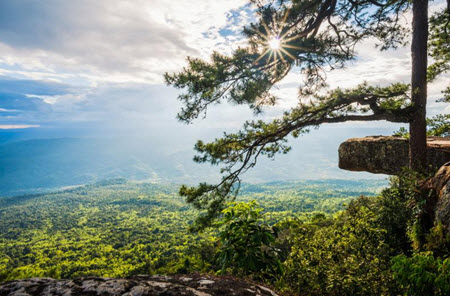 Established in 1962, the Phu Kradueng National Park is located in Isan, which is the north-eastern part of Thailand. This is the second-oldest national park in the country; Khao Yai National Park was established in September 1962 and Phu Kradueng in November that same year.
Established in 1962, the Phu Kradueng National Park is located in Isan, which is the north-eastern part of Thailand. This is the second-oldest national park in the country; Khao Yai National Park was established in September 1962 and Phu Kradueng in November that same year.
The park has a total area of 348 km2.
Just like the rest of Isan, Phu Kradueng National Park receives very little tourists compared to Bangkok and the beaches of southern and central Thailand.
Important info: This park is normally closed to visitors during the rainy season (1 June – 30 September).
Contents
Where is it?
| Coordinates | 16°52′05″N 101°46′33″E |
| Sub-district | Amphoe Phu Kradueng |
| Province | Loei Province |
| Region | Isan |
Closest airport
The nearest city is Loei, which is served by the Loei Airport (IATA: LOE, ICAO: VTUL).
At the time of writing, two airlines fly from Don Mueang Airport (IATA: DMK, ICAO: VTBD) in Bangkok to Loei Airport:
- Nok Air
- Thai Air Asia
The mountain
The Phu Kradueng mountain is steep to the south, west, and east, while only sloping gently to the north, and this gentle northern slope features streams and seasonal waterfalls.
The top of the mountain is a plateau (mesa), located roughly a kilometer or so above the surrounding valleys. The highest point is Khok Moei on the south-western part of the plateau, reaching 1,316 m above sea level.
Flora
The steep sides of the Phu Kradueng mountain sports tiers of tropical vegetation. The top tier is deciduous (i.e. not evergreen) members of the family Dipterocarpaceae, followed by a tier of mixed deciduous trees one step down. If we descend another step, we encounter a tier of evergreen trees adapted to a dry climate, and below that a tier that is chiefly of the hill evergreen forest type but interspersed with bamboo.
The top of the Phu Kradueng mountain is a large plateau (mesa) with a sandy pine savanna landscape. The trees that grow here must be able to handle the exposed location, even if it means growing in a stunted form. Examples of tree species that can be found on this mesa are Siamese sal, Red lauan, Sumatran pine, Khasi pine, and the conifer Podocarpus neriifolius.
The Savannah is also rich in herbs, including many beautiful flowers such as Bluewings and Marigolds. The rocky fields of the mountain are home to several orchid species of the genus Dendrobium here, as well as ferns, mosses and the popular bonsai choice Japanese boxthorn.
Fauna
Examples of animals that live in the park:
- Elephant
- Barking deer
- Sambar deer
- Serow (member of the genus Capricornis)
- Bear
- Fox
- Squirrel
- Tao Poo Loo (a turtle with an unusually long tail)
- Black Eagle
- Silver Pheasant
- White-rumped Shama (a passerine bird)
- Burmese francolin (member of the Partridge subfamily)
Climate
The weather on the mountain is fairly cool year round, especially at higher altitudes. The average temperature is 15 °C.
Rainy season
The rainy season is known for abrupt weather changes in the park, and heavy rains sometimes erode sandstone caps and make cliffs collapse under their own weight. Sudden heavy rains can also bring on destructive flash-floods.
Typically, the authorities will close to park to visitors during this season.
It is often very foggy during this moist part of the year.
Cool season
During the coldest nights of the cool season, freezing temperatures do occur.
